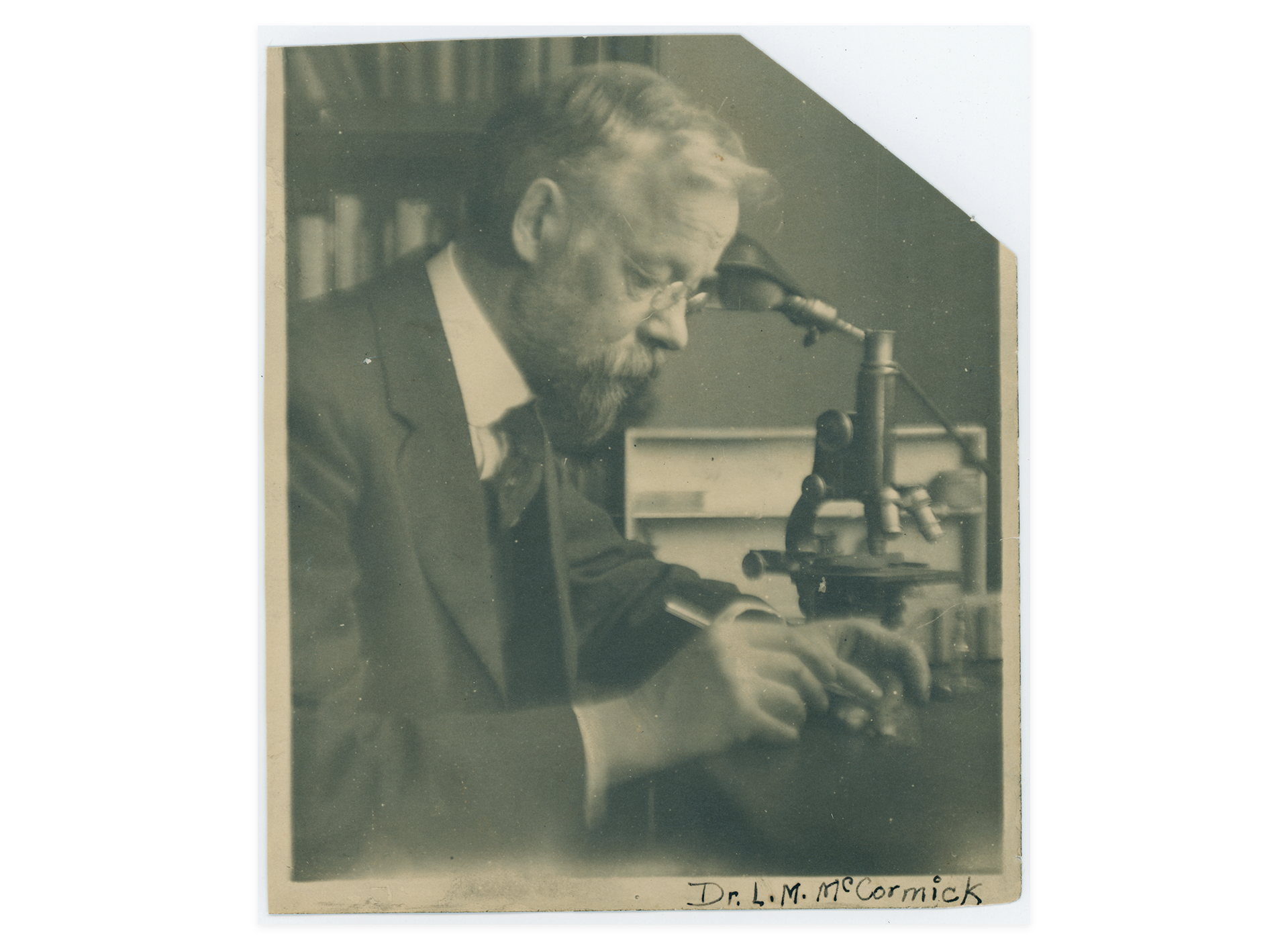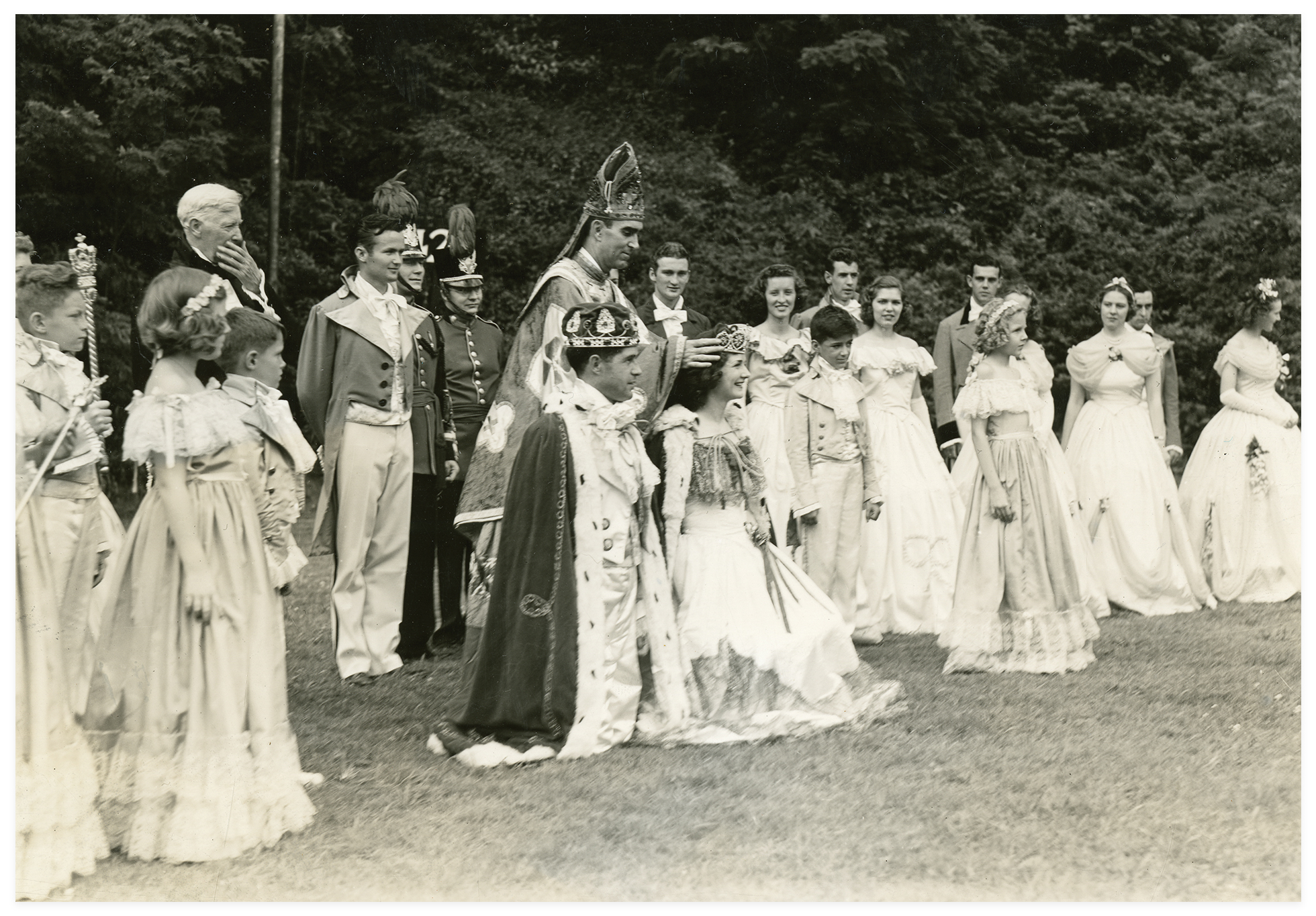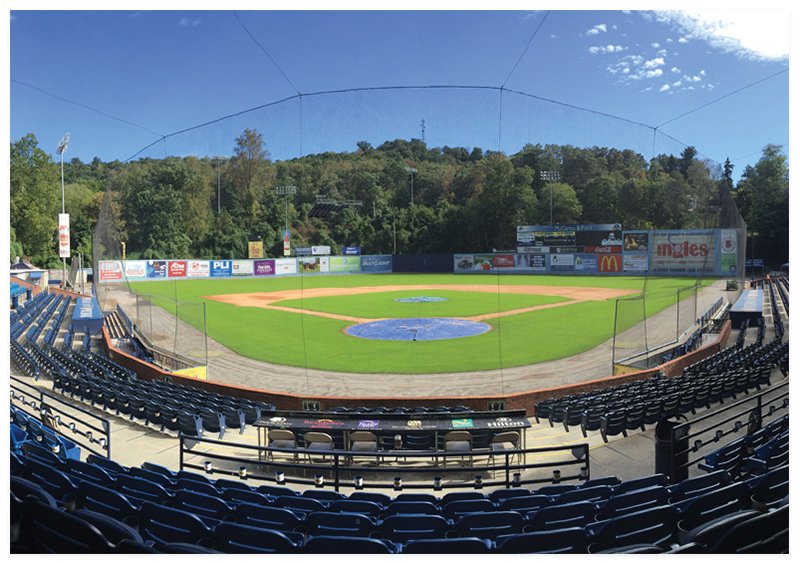Batter Up!
Batter Up!: McCormick Field celebrates its 100th anniversary, with many more seasons to come
Brian DeWine was on a mission in the late 2000s. Hoping to purchase a minor league baseball team that could become his life’s work, DeWine and his family journeyed to numerous cities to scout teams that were for sale and several that were not on the market. Considering the significance in making the right choice, the decision was not difficult. “Right here checked every box,” said the current president of the Asheville Tourists. “It was the city, the people. It was McCormick Field and the history. My wife and I knew this was where we wanted to raise our family.”
Everything has lived up to expectations during DeWine’s near-decade-and-a-half in Asheville, although the past five years have come with challenges. The pandemic cost the minor leagues the 2020 season, which was followed by Major League Baseball severing affiliations with 40 clubs in 2023. While Asheville and the aging McCormick Field made the cut, it came with a caveat. MLB placed draconian demands on the surviving 120 teams by requiring significant and specific facility upgrades. For DeWine and the Tourists, that meant generating a commitment close to $50 million.
Uncertain if his team would have to relocate if local funds were not approved, DeWine entered a joint venture with the City of Asheville, Buncombe County, and the Buncombe County Tourist Development Authority in a project deemed a “centennial restoration” of McCormick Field. Asheville City Council committed to funding $20 million of repairs and upgrades in March 2023. Buncombe County later voted in favor of funding up to $250,000 annually for 20 years for the renovations, and the Buncombe County TDA approved its largest single development investment, designating $23 million for the ballpark. The Tourists also will make a significant financial contribution. In recent years the team has paid yearly rent ranging from $1 to the current $100,000. Beginning in 2026, the Tourists will start a 20-year lease that calls for an annual payment of $450,000.
“We were fortunate in that we were overdue for upgrades,” DeWine says. “We aren’t having to spend money on top of any recent large expenditures the way some teams are.”
The financial commitments mean history will continue to be made at McCormick Field, which is celebrating its 100th anniversary during the 2024 baseball season. The ballpark site holds the distinction of hosting the third-oldest in the minor leagues, behind only Florida’s Jackie Robinson Ballpark in Daytona Beach (1914) and LECOM Park in Bradenton (1923).
The Beginning
McCormick Field was part of Asheville’s building spree in the Roaring Twenties, a time when more than 65 opulent structures with detailed architecture arose. Among them was Asheville’s first municipality-owned park that was approved when the general assembly passed a bill in May 1923. Located on a plot of land near the intersection of Biltmore Avenue and Valley Street, just south of downtown, and named for Asheville’s only bacteriologist, Dr. Lewis McCormick, the park—McCormick Field—differed from similar venues throughout the country.
Nestled against a hillside with Beaucatcher Mountain visible beyond left field, the wooden ballpark was painted green and featured a picturesque setting that was made more beautiful when Edith Vanderbilt donated Norway Spruce pines from the Biltmore estate to help conceal the low fence that circled the outfield. Unlike Asheville’s previous baseball parks—Riverside Park and Oates Park—McCormick Field was within easy walking distance to downtown and had parking for 400 cars onsite and for 1,200 vehicles within one block. It also had permanent seating for 4,000 fans and fully equipped dressing rooms. Southern Tourist magazine, in its June 1924 issue, wrote, “There is a ladies’ rest room with maid and attendant. The plumbing used at this field is the most sanitary, being of the class used in the best hotels in the country.” These features led to a total cost of $200,000, making it not only one of the most expensive but among the most modern playing facilities in the Southeast.
McCormick Field hosted a handful of high school football games in the fall of 1923. The baseball grandstands were built in early 1924 and the scoreboard, which included out-of-town South Atlantic League games, was installed on March 26, 1924. On that same day, Asheville High defeated Hendersonville High, 24-3, in the first baseball game at the facility. After the Asheville Skylanders (soon to be known as the Tourists) played a few exhibition games against local competition, the team hosted the Detroit Tigers on April 3.
On April 3, 2024, the Tourists played an exhibition game against the Fayetteville Woodpeckers to commemorate the 100th anniversary of Asheville’s 18-14 win over Detroit. Tickets cost 75 cents and sold out in less than 90 minutes. As usual, Dorland Winkler, a retired Buncombe County school administrator, was among the first through the gates. “It really is hallowed ground,” notes Winkler, who began attending games at McCormick Field in 1972. “You can count on one hand the number of sites in the country that can say baseball is still being played in the same location since 1924. And how many can say that Babe Ruth, Ty Cobb, Jackie Robinson, Dizzy Dean, Willie Stargell, Roberto Clemente and so many others played there? That gives me goosebumps, and it just speaks to what a special place this is.”
Featuring a sign that ran the length of the left-field grandstand and read “Asheville—The Playground of America,” McCormick Field was officially dedicated on April 21, 1924, which marked the Skylanders’ home opener in the South Atlantic League, against the Greenville Spinners. A pair of local bands played “Hail, Hail,” and roses were given to all women among the 4,268 fans in attendance and were pinned on each member of the two teams. The Asheville Times wrote in its edition that day, “McCormick Field is one of the best baseball parks in the south, and there is hardly a city the size of Asheville that can boast of such a fine field.”
Although city leaders envisioned McCormick Field hosting high school and collegiate football games and track meets (a quarter-mile cinder track bordered the field), the ballpark established itself immediately as a baseball paradise. Major league teams added exhibition games in Asheville while returning from spring training in Florida. Playing with the Yankees for three exhibition games in 1931 (the same year New York considered holding spring training at McCormick Field), Babe Ruth raved, “What a ballpark! What a beautiful place to play!” As general manager of the St. Louis Cardinals, Branch Rickey established the first formal working agreement with the Tourists in 1935 in part because he loved the rhododendron and the sweet aroma of honeysuckle that filled the facility.
The Games
The quality of baseball played oftentimes matched the setting. The Tourists won their first championship in 1928 with a 97-48 record and a franchise-best .664 winning percentage. Outfielder Dusty Cooke and shortstop Ben Chapman had remarkable showings and were among six players sold to major league teams by the Tourists at the end of the season.
After less than two years in the Piedmont League, the Tourists disbanded on July 7, 1932, at the height of the Great Depression but returned to the circuit in 1934 and remained until 1942. In the spring of 1935 Rickey and the Cardinals sent three other minor league teams to train with the Tourists at McCormick Field. On March 28, 1935, the ballpark suffered significant fire damage. Baseball activities were uninterrupted while new wooden grandstands were built down the first base line. The Tourists won the Piedmont League regular season in 1935 under future Hall of Fame manager Billy Southworth and added pennants under skipper Harold Anderson in 1937 and 1939.
World War II brought much of minor league baseball to a halt from 1943-45, including Asheville. The war, however, did not mean McCormick Field was without baseball. The ballpark was used for games between military personnel assigned to various units stationed in Asheville. Moore General Hospital and the Asheville Redistribution Station fielded teams that featured a handful of major league players.
McCormick Field was also used by the local African American teams, beginning with the Black Tourists from 1929 through the 1930s and continuing with the Asheville Blues in the 1940s. Clarence Moore taught and coached at Stephens-Lee High School and was a prominent player and manager of the Black Tourists prior to taking ownership of the Blues in the 1940s. Under Moore’s guidance, the Blues emerged as one of the most dominant teams in the Southeast and won the Negro Southern League in 1946 and 1947.
The Tourists returned in 1946 and resumed a working relationship with Rickey, who was running the Brooklyn Dodgers. More success followed, with Asheville winning the Tri-State League regular season under manager Clay Bryant in 1948 and under Ray Hathaway in 1954. In three separate stints with the Tourists that totaled seven and one-half seasons, Hathaway won 518 games with the Tourists and two pennants and remained a full-time resident of Asheville after his baseball career concluded.
Baseball Returns
After hosting stock car racing from 1956 to ’58, McCormick Field welcomed back the Tourists in 1959 thanks to the efforts of Asheville Chamber of Commerce president Fleming Talman and the non-profit Community Baseball, Inc. The team served as the Class AA affiliate of the Pittsburgh Pirates from 1961-66. Hathaway guided Asheville to the South Atlantic League title in 1961, and nine players, including future Hall of Famer Willie Stargell, later played in the major leagues. Following a one-year stint with Houston in the Carolina League in 1967, Hall of Fame manager Sparky Anderson opened the Cincinnati Reds’ three-year stretch in Asheville by winning the 1968 Southern League title.
Lawyer Al Harazin paid $10,000 for controlling interest in the team in 1972 and was aided by a stock sale of $10 shares conducted by Talman and banker George Chumbley. The Baltimore Orioles moved their Double-A club from Dallas-Fort Worth to Asheville, a relationship that ran through 1975. At the major league affiliate’s request, McCormick Field’s wooden seats were painted orange, and the team went by the nickname Orioles, or O’s, for short. Manager Cal Ripken, Sr., with his sons Cal Jr., Billy, and Fred serving as batboys, led the team to a Southern League-best 81-58 record in 1972.
“The Ripken boys came to Asheville once school got out in Maryland and Cal Sr. would throw batting practice to them at McCormick Field,” says Jim Baker, who helped Harazin in the front office and was later a reporter for the Asheville Citizen-Times, official scorer, and season ticket holder at the ballpark. “Of course, I had no idea Cal Jr. would be a Hall of Famer, but you could tell he had an incredible amount of ability.”
When the Orioles left for Charlotte at the end of the 1975 season, Asheville joined the struggling Western Carolinas League and spent four seasons as the Class A affiliate of the Texas Rangers, with Wayne Terwilliger managing every slate. Just prior to the start of the 1978 campaign, a local group of investors headed by general manager Merrill Eckstein bought the Tourists from Pro-Ball, Inc., which operated the team in 1976 and 1977.
Read More McCormick Field Highlights
The Astros replaced the Rangers as the major league affiliate in 1980, which coincided with the arrival of Ron McKee as Asheville’s general manager and Woody Kern as majority owner. For the next quarter-century McKee and his wife, Carolyn, built the Tourists into one of the minors’ strongest franchises. “I felt that when people came to the ballpark that I was having them over to my house to eat dinner and enjoy the evening,” says McKee, who created a family atmosphere and instituted such original promotional ideas as Thirsty Thursday. He also oversaw the rebuilding of the ballpark between the 1991 and 1992 seasons, which included the demolition of the deteriorating wooden structure and erecting a brick and concrete facility with a new grandstand, home clubhouse, concession stands, and offices at a cost of $2.8 million.
Having won the 1984 SAL championship as part of the Houston organization, the Tourists became an inaugural member of the expansion Colorado Rockies farm system in 1994 and maintained that relationship for 26 seasons. Thirteen of those campaigns were managed by Joe Mikulik, an outfielder on the 1987 Tourists who proceeded to establish the longest tenure of any manager of an affiliated minor league team in baseball history. Known for his passion, Mikulik won a franchise-record 938 games, with the apex coming in 2012 when he led the Tourists to the SAL championship. “I loved playing there and I loved managing there,” notes Mikulik. “Asheville was my home for many years, and many of my best memories in baseball took place at McCormick Field.”
During Mikulik’s tenure, the team changed ownership on two occasions. In October 2005 Palace Sports & Entertainment, who also owned the NBA’s Detroit Pistons and NHL’s Tampa Bay Lightning, bought the Tourists from Kern and McKee before DeWine Silver Dollar Baseball acquired the franchise in January 2010. Under Palace’s direction McCormick Field received a new video scoreboard, outfield fence, and suite accommodations, while DeWine oversaw several ballpark improvements, highlighted by new chair-back seats.
The Future
For one of the rare few times in its storied history, McCormick Field’s future is as bright as the day it opened 100 years ago. Construction will begin immediately after this season’s conclusion and is expected to take two years to complete by working continuously from September through March while being scaled back during the 2025 season.
The diamond will remain in place, and the current seating will not be altered. The changes include a new main entrance, team store, box office, and playing surface. The current home clubhouse underneath the first-base stands will become the visitors’ locker room, while a new home clubhouse, along with batting cages, weight room, dining facilities, and dressing rooms for male and female coaching and umpiring staffs will be built on the third base side of the field. The fan experience will be upgraded in numerous ways, including a new scoreboard in left field and a more spacious plaza around the concession stands. By April 1, 2026, McCormick Field should feel like a new ballpark.
“What makes this entire process so special is that at the beginning we didn’t know if the Tourists would be here another two years,” DeWine notes. “Instead, everyone came together to save professional baseball in Asheville for the next generation. And to do that here at McCormick Field, where so much history has already been made, makes all this so rewarding.”

Who was Dr. Lewis McCormick (pictured above)?
Nicknamed “the Fly Man,” McCormick was a well-traveled researcher who started the “Swat That Fly” campaign to reduce the number of the disease-carrying pests in the city.
He also was instrumental in protecting the city’s water and milk supply. McCormick was described as a man of high ideals, modesty, and reserve.

(From left to right) Sparky Anderson; Eddie Murray; Billy Southworth; Craig Biggio & Todd Helton
Baseball’s Best - Hall of Famers from McCormick Field
Sparky Anderson (inducted 2000)
Anderson managed the Tourists to the Southern League pennant in 1968. He won the World Series with Cincinnati in 1975 and 1976 and with Detroit in 1984, becoming the first skipper to accomplish the feat in both the American and National leagues.
Eddie Murray (inducted 2003)
After a brief trial with Asheville in 1974, Murray returned to McCormick Field a year later and learned to switch-hit. He was the AL Rookie of the Year in 1977 and accumulated 3,255 hits and 504 home runs in 21 big league seasons.
Billy Southworth (inducted 2008)
Southworth served as a player and manager with Asheville in 1935 and 1936. He managed nine seasons in the major leagues, winning four pennants.
Craig Biggio (inducted 2015)
Biggio joined the Tourists midway through the 1987 season as the Astros’ first-round pick out of Seton Hall. In 20 seasons with Houston, he became the first player in history with at least 3,000 hits, 600 doubles, 400 steals, and 250 home runs.
Todd Helton (inducted July 21, 2024)
Helton becomes the fifth former Asheville player or manager to be inducted into the Baseball Hall of Fame. A two-sport star at Tennessee, Helton joined the Tourists in 1995 as a first-round pick of the Rockies. He played 17 seasons for Colorado and batted .316 with 369 home runs.

At the 12th annual Rhodedendron Festival in 1939, a king and queen are selected.
Not Just Baseball
McCormick Field has hosted a variety of events other than baseball. In the 1930s, part of the annual Rhododendron Festival was held at the ballpark. On September 10, 1936, while on the campaign trail, US president Franklin Delano Roosevelt spoke to an estimated crowd of 20,000. In baseball’s absence from 1956-58, a quarter-mile asphalt track and a concrete wall were installed, and weekly stock car races were held. Banjo Matthews won 13 consecutive sportsman division races.
A 15-second scene for the movie Bull Durham was shot at the ballpark on October 5-6, 1987. Kevin Costner’s character Crash Davis breaks the minor league home run record as a member of the Tourists at McCormick Field.
Although many smaller concerts were held at the ballpark in the 1950s and 1960s, none compared to the two most recent performances. The Indigo Girls played at McCormick Field on September 30, 2006, while more than 12,000 attended the Florida Georgia Line and Nelly concert on June 22, 2014.
